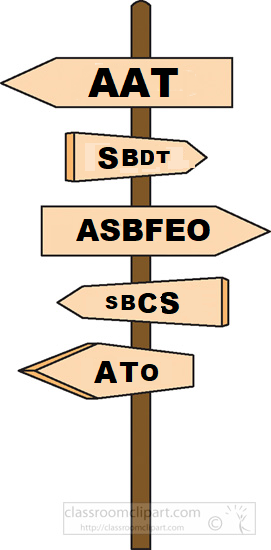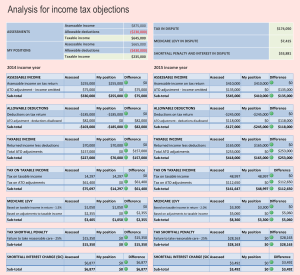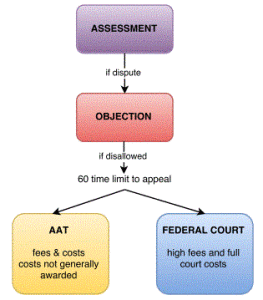
A recent Federal Court case Price v. Commissioner of Taxation [2019] FCA 543 demonstrates the divergent way a taxpayer must go about contesting a dispute with the Commissioner of Taxation over pay as you go (PAYG) tax withholding amounts taken from salary or wages received by the taxpayer.
Right to object about PAYG credits not available
Although the credit for PAYG withholding amounts is notified on a notice of assessment of income tax the PAYG credit is not one of the matters that can be disputed by objection, or more specifically, an objection under Part IVC of the Taxation Administration Act (C’th) 1953 (“TAA”) as discussed on this blog in: Is an objection needed to amend a tax assessment? https://wp.me/p6T4vg-k.
To formally dispute a PAYG credit, especially where the salary and wages from which the withholding is made are not disputed, court action may need to be taken instead. The proceeding that can be taken by a taxpayer is further limited as the Commissioner’s refusal to allow PAYG credits cannot be challenged under the Administrative Decisions (Judicial Review) Act (C’th) 1977: Perdikaris v Deputy Commissioner of Taxation [2008] FCAFC 186. So in Price, the taxpayer (Robert) sought a declaration from the Federal Court of his entitlement to credit for PAYG withheld by his employers under section 39B of the Judiciary Act (C’th) 1903.
Price v. Commissioner of Taxation
In paragraphs 6 to 8 of the Federal Court decision in Price, Thawley J. outlined the legislative basis of the PAYG withholding regime including in the context of the predecessor PAYE (pay as you earn) regime which operated until 2000. In paragraph 2 Thawley J. confirmed that the taxpayer’s proceeding under section 39B of the Judiciary Act, rather than under Part IVC of the TAA, was correctly instigated.
Why the taxpayer risked heavy costs in the Federal Court
Action in the Federal Court is expensive, and an unsuccessful litigant in the court is generally liable for the legal costs of the successful litigant. Those legal costs are significantly more than the costs of lodging an objection or appealing against an objection decision with which the objector is dissatisfied in the Administrative Appeals Tribunal (AAT) which are costs risked in Part IVC of the TAA disputes. The AAT does not award legal costs.
It follows that considerable PAYG credits need to be in dispute before action against the Commissioner in the Federal Court is worth the risk of legal costs at stake.
In Price, Robert was employed as a truck driver by four entities controlled by his brother Jim from the 2001 to the 2016 income years. Robert claimed PAYG credits for the entire period so considerable PAYG credit entitlements were at stake. Robert hadn’t lodged tax returns returning his salary and wages income until 26 September 2016 when all sixteen income tax returns were lodged together. Robert sought all sixteen years’ worth of tax credits then.
The employer and not the Commissioner is tested
One would think that the Commissioner could easily ascertain PAYG credit from amounts remitted by an employer for a recipient of salary and wages. If amounts withheld from salary and wages haven’t been remitted to the Australian Taxation Office (ATO) then that would seemingly be conclusive or near conclusive.
But the point of remittance of PAYG credits to the ATO is not the point at which the TAA operates to confer a PAYG credit entitlement to a taxpayer. Sub-section 18-15(1) of Schedule 1 of the TAA allows PAYG credit to a taxpayer where there has been withholding by the party with the withholding obligation, viz. the employer in the case of an employer who pays salary and wages, of the amount withheld. Sub-section 18-15(1) necessitates an enquiry into whether or not the amounts claimed for PAYG credit were “withheld” by the employer whether or not the amounts “withheld” were ever remitted to the Commissioner. In the Federal Court, in its original (non-appellate) jurisdiction, whether amounts have been withheld is a matter of fact to be established to the court on the balance of probabilities.
In another Federal Court decision cited with approval in Price, David Cassaniti v Commissioner of Taxation [2010] FCA 641 at paragraphs 163 to 165 Edmonds J. thus focussed on the actions of the employer. Edmonds J. explained and contrasted the evidential value of an employer’s apparent withholding to a (its own) bank account which, on the one hand, “clearly demonstrates” a withholding and an employer’s apparent withholding by book entry, which may be insufficient to demonstrate withholding by the employer depending on the surrounding circumstances, on the other. It was also relevant in David Cassaniti, as it was in Price, that the employer had been a company enabling Edmonds J to accept the books of account of the company as first instance evidence of what the books of account contained in accordance with section 1305 of the Corporations Act 2001.
Employers were wound up companies
In the Cassaniti line of cases, which also included the Full Federal Court decision in Commissioner of Taxation v Cassaniti [2018] FCAFC 212, relevant company records of the employers were thus sufficient to establish to the Federal Court that amounts had been withheld by the party with the withholding obligation. As in Price, in which the Cassanitis were also involved, the relevant employer companies had been wound up but nevertheless, by virtue of section 1305 of the Corporations Act 2001, the financial records of these companies in the (earlier) Cassaniti cases were sufficient evidence to show that the companies had made the relevant withholdings despite no record of remittance to the ATO. Robert’s case in Price relied on PAYG payment summaries produced from accounting records of the employer companies being accepted as financial records of the companies.
Robert was unsuccessful. The tax returns and PAYG payment summaries were produced from MYOB in September 2016 after the employers were wound up so the court refused to accept the PAYG payment summaries as financial records of the wound up companies. Thus the PAYG payment summaries were not first instance evidence of the PAYG withholdings asserted in them. In paragraph 87 Thawley J. listed findings showing that withholdings were not made for Robert:
- the absence of any records from the ATO to that effect or supporting inferences of withholding;
- the absence of any contemporaneous record of any person or entity who paid Robert evidencing withholding;
- the fact that every year or thereabouts Robert asked for but was not provided any PAYG payment summary;
- the fact that no superannuation was paid by any of the employer companies for Robert;
- the fact that Allyma Transport Services did prepare PAYG payment summaries for other employees; and
- the fact that the bank records suggest a number of different entities paid the weekly amounts into Robert’s account (including NT TPT Pty Ltd, PMG Transport, CJN Transport) and that at least one of those entities (PMG Transport) probably treated the payments to Robert on the basis that he (or a partnership of which he was a partner) was a subcontractor rather than an employee.
The unremitted PAYG no man’s land
Cases such as the Cassaniti cases and Price are relatively rare. In that context we can observe that it is precarious to be in the position of an employer, or of a director of an employer, obligated to withhold PAYG amounts from employees’ salary and wages where those amounts have not been remitted to the ATO. The employer and, in the case of a company, its directors personally where director penalty notices issue to the directors and trigger personal liability under Division 269 of Schedule 1 of the TAA, are liable to the Commissioner for these amounts. Further failure to remit PAYG withholding on salary and wages is a strict liability offence under Division 16 of Schedule 1 of the TAA.
The pursuit of unremitted salary and wage PAYG withholdings from the Commissioner can potentially be a fraud against the revenue where employers and their directors have overtly arranged their affairs so that they are not exposed to the above liabilities and prosecution for failure to remit. Confinement of salary and wage earner remedy to proceedings under section 39B of the Judiciary Act does operate as a bulwark against that type of fraud.
It is to be hoped that reporting of and liability for PAYG withholding on salary and wages can be reformed and streamlined so that employees can better monitor withholding for them in real time and opportunities for “phoenix” PAYG credit frauds on the revenue can be reduced.



